寻找结局:一座表彰牺牲英雄的建筑

The airport was uncommonly silent the day that the remains of U.S. Air Force Colonel Roy Knight returned home from overseas. For a brief moment in the middle of an otherwise normal day at Dallas Love Field, passengers and airline staff stood in silence—a show of respect and honor for a fallen U.S. service member and local hero.
This Texas homecoming wasn’t simple. In fact, many people from around the globe worked tirelessly to help make this family reunion a reality. The journey was only possible because of the work of the Defense POW/MIA Accounting Agency (DPAA) and its partners.
The Mission
Staff at the U.S. military’s two DPAA laboratories—located on the Hawaiian island of Oahu and in Omaha, Nebraska—are resolute in embracing the mission of their organization: to provide “the fullest possible accounting for our missing personnel from past conflicts to their families and the nation.[1]”
The need to reunite the fallen with their families is great and the caseload is tremendous. As of August 30, 2019, the DPAA was tracking approximately 82,000 Americans missing in conflicts spanning from World War II to Operation Iraqi Freedom.[2] In 2018, the agency successfully accounted for 203 service members from various locations around the globe.[3] Though the task can be long, arduous, and frequently requires travel to previous areas of conflict, DPAA staff work steadily to account for each and every person in their database.
The U.S. military recognized that the DPAA needed additional laboratory space to accommodate its ongoing operations. SmithGroup was honored to support this important mission. Having designed both of the Defense POW/MIA Accounting Agency’s Forensic Identification Laboratories in Hawaii and Nebraska, our team has witnessed first-hand the tireless dedication of the anthropologists, archaeologists, and forensic odontologists that work in these facilities. We set out to create a building that supports the scientific rigor and solemnity that this challenging, honorable work deserves.

Building to Support the Mission
Designing a building to house the largest and most diverse forensic identification laboratory in the world[1] while respecting local architectural vocabularies required attention to detail. For the facility on Oahu—which consolidated operations previously dispersed across three military locations on the island—the team utilized structural concrete and pre-cast concrete panels which were manufactured on the island and fashioned with an abstracted Hawaiian pattern to create the primary architectural aesthetic.
The new, 137,000 square foot facility houses some of the industry’s most advanced instrumentation and investigative laboratory spaces within a highly adaptable and flexible working environment. Large central identification laboratories provide space necessary for organizing physical remains and artifacts retrieved from recovery sites. Critical spaces such as imaging rooms for collecting comparison radiographs, orderly spaces for extracting mitochondrial DNA, and storage for material evidence also support research activities that are necessary to obtain a positive identification.
The facility provides ample space to support the deployment of recovery missions. Recovery missions are international, remote, and require a vast array of equipment and scientific personnel to recover anthropological evidence. The staging spaces give the logistics team the flexibility necessary to plan, layout and prepare equipment for each unique recovery mission.
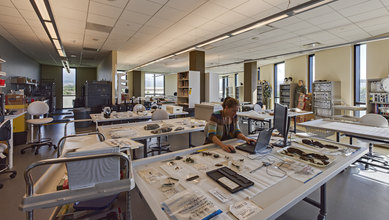
Designers also took great care to ensure that the building addressed the emotional needs of employees charged with undertaking this challenging work. To promote a healthy work environment, the team incorporated access to natural daylight, provided views between spaces to reduce eye strain, and included a comfortable break-out space for socializing and collaboration. Finally, a three-story garden area with outdoor lanais provides staff a place for respite.
However, some of the most powerful spaces are those dedicated to family members. A unique shade trellis welcomes families and visitors to this highly secure, yet public facility. A collection of material from multiple conflicts is displayed in a small museum space to better inform visitors of how the DPAA completes its mission. At the top floor, a family viewing room that seems to float above the courtyard provides a private, serene space for families to reunite with their deceased loved ones.
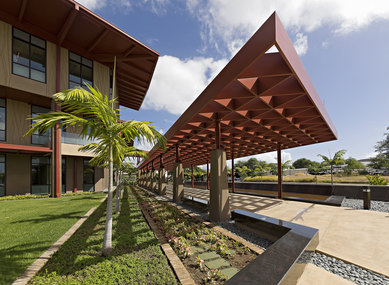
A one of a kind shade trellis marks the entry and greets visitors.
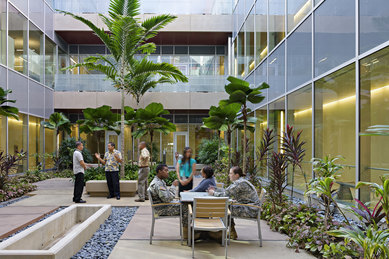
The central courtyard provides staff a place to connect or rest and reflect.
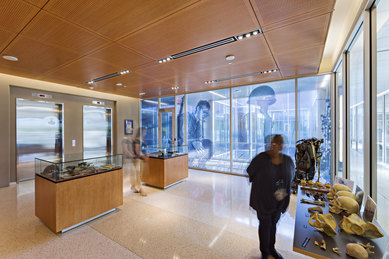
A small interpretive museum informs visitors about the agency's mission.
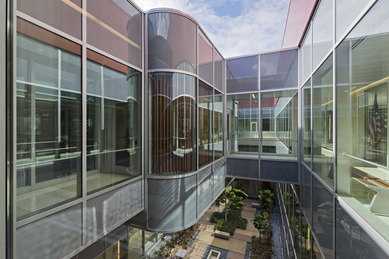
A serene, solemn family viewing area floats above the landscaped courtyard.
When Will the Mission Be Complete?
While the complex and time-consuming nature of work conducted by the DPAA makes it impossible to estimate how long it might take to complete the organization’s mission, this world-class forensic laboratory will support personnel as they proceed “case by case, individual by individual, and family by family[5]” until their work is done.
"Today there are still 82,000 service members that have gone unidentified. This project helps facilitate the identification through DNA. This facility is at the center of that mission."
-Stephanie Mitrovic, Principal, Science & Technology Studio Leader
[1] https://www.dpaa.mil/Our-Missing/Past-Conflicts/
[2] https://www.dpaa.mil/Our-Missing/Past-Conflicts/
[3] https://www.dpaa.mil/News-Stories/Recent-News-Stories/Article/1649507/dpaa-accounts-for-203-missing-personnel-in-fiscal-year-2018/
[4] https://www.dpaa.mil/Resources/Fact-Sheets/Article-View/Article/569602/dpaa-laboratory/
[5] https://www.dpaa.mil/Resources/FAQs/